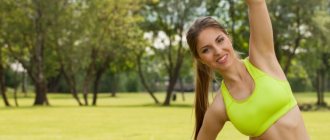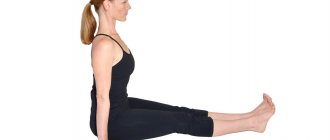Anyone at least once in their life has experienced problems waking up in the morning. With the wrong lifestyle, waking up becomes more and more difficult every year, and the consequences of lack of sleep continue throughout the day. To get rid of the state of weakness, increase your level of vigor and start a new day with joy, we offer you a special morning yoga complex.
- A set of yoga exercises for the morning - Comfortable pose (Sukhasana)
- Video: How to do Sukhasana correctly
- Neck warm-up
- Tilts the head back and forth
- Head tilts to the sides
- Head rotation
- Lateral bends from Sukhasana
- Warm-up for chest and back
- Chair Pose (Utkasana)
- Video: How to perform Utkatasana correctly
- Warrior Pose I (Virabhadrasana I)
- Video: Nuances of performing Warrior I pose
- Twisted Side Angle Pose (Parivritta Parsvakonasana)
- Video: How to do Twisted Side Angle pose correctly
- Downward Facing Dog Pose (Adho Mukha Svanasana)
- Video: Downward Facing Dog for Beginners
- Upward Facing Dog Pose (Urdhva Mukha Svanasana)
- Video: Making Upward Facing Dog correctly
- Hare Pose (Shashankasana)
- Dead Body Pose (Savasana)
- Video: Morning Shavasana
A set of yoga exercises for the morning - Comfortable pose (Sukhasana)
Let's start our morning with Sukhasana. The very name of this asana translates as “comfortable pose.” “In the world” this position is referred to as “sitting cross-legged.” Many people, even those who do not practice yoga, intuitively sit in this position because it is really simple and comfortable. However, Sukhasana has its own nuances that must be observed to achieve maximum effectiveness.
- We sit down on a hard surface, straighten our back, stretch our legs forward.
- Bend your right leg, pulling its heel towards the inside of your left thigh.
- Having bent the left leg, we place its shin on the right shin, and put the foot between the thigh and calf of the right leg, under the right knee.
- We spread our knees wide and relax our feet.
- We place our hands on our knees, and our palms can look both up and down, and our elbows should be exactly under our shoulders.
- We reach up behind the top of the head, straightening our back.
- You can close your eyes to concentrate on the sensations.
To keep your back straight, slightly arch your lower back, straighten your chest, but do not raise your shoulders. Also make sure that the head remains in line with the entire body.
This simple pose will improve the performance of the joints of the lower extremities, strengthen the back, normalize blood circulation and the functioning of the gastrointestinal tract.
The best pose to prepare for practice
Now, to tune in to the activity, direct your attention to your breathing. Try to breathe evenly through both your stomach and chest. Breathe a little deeper and slower than usual. Now try to move your attention throughout your body - from the top of your head to your toes and back. This will help you establish contact with your body and tune in to practice.
Video: How to do Sukhasana correctly
Having tuned in properly and without leaving a comfortable position, we begin training individual parts of the body.
Yoga for 15 minutes in the morning, which is easy to do at home
It is advisable to include a morning yoga routine for beginners only in regular asanas, which take 15 minutes to complete. More complex elements in the technical field require enormous energy, concentration and coordination. There are even more benefits if their implementation is postponed until the evening.
Before you begin your lesson, take time to invigorate yourself spiritually and regain your breath.
Setting a goal - 2 minutes
You need to take a comfortable position, close your eyes, relax and take 2 minutes to control the emotions in your body and the ideas that come to mind. There is no need to think about the question of what things await you.
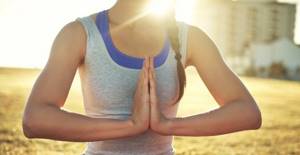
If you feel tension in your body, gradually release it from your fingertips to your feet. You must agree to peace and quiet. The purpose of morning exercises is to track your emotions and evoke those that are needed.
Practice even breathing - 3 minutes
In this position, it is convenient to sit on the floor or carpet, which will be more comfortable. You should breathe through your nose and count to yourself. Inhale for 3 counts, exhale for 3 counts. If necessary, the length can be increased to 5-6 or vice versa. It is important that the body does not feel uncomfortable. Focus on your feelings.
If you exhale twice as long as you inhale, it will have a calming effect. For example, breathing is done in two counts, and exhaled in 4. After you have managed to smooth out your breathing, relax your mind and body, you can begin to perform asanas.
Neck warm-up
While remaining in Sukhasana, let's begin to warm up the neck muscles.
Tilts the head back and forth
The first point is head tilts, which are performed as follows:
- While in Sukhasana, straighten the spine and smoothly lower the head forward, exhaling.
- Exhaling calmly, we return to the neutral position.
- Repeat the above steps 8 times.

Bends are performed at an average pace
Throughout the entire exercise, the shoulders, torso, upper and lower limbs should be motionless, only the head moves.
Head tilts to the sides
Next, we tilt our heads left and right.
- Sitting in Sukhasana, we relax the shoulder muscles.
- As you exhale, calmly tilt your head to the right, stretch the neck muscles, but do not allow it to bend. Pull your top ear toward the ceiling, not your bottom ear toward your shoulder.
- While inhaling, we return to the original position.
- Smoothly tilt your head to the left.
- We do the described movements 4-5 times in each direction.
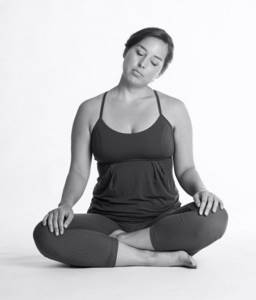
Great exercise to strengthen your neck
Let's give our muscles a little rest and proceed to the next exercise.
Head rotation
You can move on to the final part of the neck warm-up - head rotation - only after the previous exercises, when it is already sufficiently prepared.
- We sit in Sukhasana with a straight back.
- As you exhale, lower your head, bringing your chin closer to your neck, and begin to outline a circle. When the head goes up, we inhale, when down, we exhale.
- Slowly make 3-5 circles in one direction.
- We stop, raise our head, slightly stretching upward, and again tilt our head towards the chest.
- We outline 3-5 circles in the opposite direction.
Remember that the amplitude should be small; we focus on stretching behind the crown, not allowing the head to freely tilt back or to the sides.
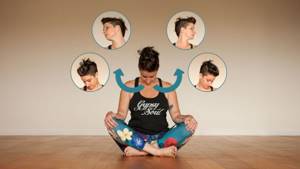
Don't do this exercise at the beginning of your warm-up.
Be sure to control your condition while performing rotations. If you begin to feel unwell or in pain, stop any head movements and calmly take deep breaths.
Benefits of practice
“Salutations to the Sun” (or “Hello Sun”) is a set of exercises aimed at overall strengthening the body and its restoration. The complex is aimed at improving mental and physical well-being and is suitable for those people who experience frequent stress, get tired easily or feel restless.
The exercises in this complex are called “asanas” and before you start performing them, you should familiarize yourself with the techniques, their benefits and disadvantages. Sun Salutation is translated from Sanskrit as Surya Namaskar. The exercises belong to hatha yoga, which means that this complex combines physical activity and breathing control.
Regular performance of asanas guarantees improvement of a person’s health and mental state.
Yogis are sure that by directing their gratitude and friendliness to the sun, a person receives return energy from it, which fills him with strength and health. Surya Namaskar is suitable even for beginners; the exercises are not complicated and easy to do.
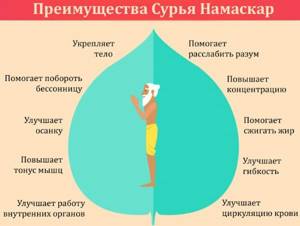
The figure lists the benefits of the Sun Salutation exercise set.
However, it is worth remembering that you need to monitor not only the work of the muscular system, but also breathing, which is an important component of the complex. You can add meditation to these asanas, and, if desired, even read mantras. Thus, there is an active impact on the spiritual part of a person, clearing thoughts and relaxing, and this is a good help with frequent stress.
Practitioners of Surya Namaskar note the following benefits from performing the exercises:
- exercises do not require special sports equipment, it can be done even without being at home;
- Regular implementation of the complex develops flexibility and mobility of the body;
- asanas invigorate the body and work better than a cup of strong coffee;
- pathologies such as “salt deposits”, muscle tightness and others immediately disappear after execution;
- there is a natural acceleration of metabolism;
- has a beneficial effect not only on muscles, but also on internal organs, restoring their function;
- If we consider techniques from a spiritual point of view, then Surya Namaskara is a way to release a person’s internal energy, to feel a surge of enormous power coming from the sun.
The Sun Salutation asanas are so simple in their execution that they can be performed even with children. At the same time, the child will receive a charge of good mood. The history of Surya Namaskar dates back to ancient times. It was invented by ancient Hindu yogis. The creation of the practice is also associated with the three deities of India - Brahma, Vishnu and Shiva.
They designated 3 phases of the sun according to the movement of the luminary. Brahma meant sunrise (the birth of the sun), Vishnu meant the daytime procession, and Shiva meant sunset (the luminary dies). Particular attention was paid to the sunrise; for the people of that time, this meant the onset of a magical time when everything around awakens.
Surya Namaskar was used to honor the sun. It was carried out several times a day - 108 times in the morning, 64 before sunset. This practice could be used as an independent set of exercises, but some used it as preparation for further performance of other asanas. This was especially common in the Himalayas, where yogis performed this complex in order to warm up.
Even now, for some Hindus, Surya Namaskar is of great importance. Yogis interpret the performance of asanas as “freeing the mind.” Each of the poses has its own designation and a mantra is read for each. The points that are activated on the body also matter during the procedure. And the most important thing is breathing.
Carefully monitoring your breathing rhythm helps a person move away from internal dialogue and an endless stream of thoughts. There are yogas for which Surya Namaskara is not a mandatory element of the main practice, and some do not use it at all.
Lateral bends from Sukhasana
Let's do some stretching and relax the sides of our torso.
- Remaining in Sukhasana, we stretch our right arm up and tense our abdominal muscles.
- Leaning on your left arm, as you exhale, slowly bend to the left until you feel tension and stretching of the oblique muscles. We linger in this position, trying to bend a little lower with each exhalation, and with each inhalation, stretch our hand a little further to the side.
- As you inhale, take the starting asana.
- Raise your left hand and tilt to the right, leaning on your right hand.
- We bend over 3-4 times in each direction.
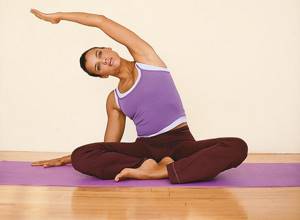
Side bends will help you find a beautiful waist
All movements are performed evenly and slowly.
Warm-up for chest and back
The final invigorating exercise performed while sitting in Sukhasana is rounding the chest and back.
- We sit in the initial asana with a straight back, clasping our knees with our hands.
- As you inhale, we bend in the lumbar region and expand the chest, pushing it up.
- We remain in this position for several seconds.
As you exhale, we move the body back, rounding the back and slightly tilting the head, pulling the navel towards the spine.
We repeat the exercise about 10 times, trying to evenly stretch the back and front surfaces of the body. We always complete the exercise with a round back, moving from this position to neutral as we inhale.
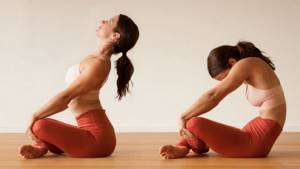
Try to bend as much as possible
Rounding the back and chest perfectly warms up the muscles of the entire body, stretching and massaging them.
Chair Pose (Utkasana)
Having warmed up thoroughly while sitting, we move on to asanas from a standing position. One of the simple, but very useful poses is the Chair pose, also known as Utkatasana (see video).
- We stand straight, legs together, heels pressed firmly to the floor.
- Bend your knees so that your knees do not go beyond the line of your toes and look forward.
- We tilt the pelvis back, do not bend the back in the lower back, pull in the stomach, twist the tailbone towards ourselves.
- We stretch our arms in front of us or up, holding them parallel to each other.
- We move our shoulders back and down, we try to straighten our chest and pull it up.
- We remain in the asana for 30–45 seconds.
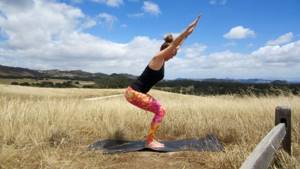
The higher your arms are raised, the more your chest opens.
Chair pose is very beneficial, it strengthens the pelvis, hips, knees and ankles. Corrects flat feet, posture, normalizes the functioning of the cardiovascular system, diaphragm and abdominal organs, trains balance, and tones the body.
Video: How to perform Utkatasana correctly
Hatha yoga asanas for beginners
Before you start practicing hatha yoga, tune into a wave of calm, let go of all problems and create an atmosphere. Open a window or go to the park, lay down a yoga mat, close your eyes and perform 7 simple and useful hatha yoga asanas.
Hold each asana for 1 minute. Remember to breathe deeply and focus on your sensations.
Garudasana - eagle pose
Garudasana is an interlacing of the upper and lower limbs.
Stand up straight and bend your knees. Hugging the thigh, shin and foot of one leg to the other. Bend your elbows and place them in front of you so that one arm wraps around the other. The most difficult thing in garudasana is maintaining balance.
Contraindications : injury to the knee and elbow joints.
Vrksasana - tree pose
Vrikshasana is the most popular asana of Hatha yoga for maintaining balance.
To perform the asana, stand on two legs, breathe calmly and evenly. lift one leg and place it on the inner thigh of the other leg. Hold your balance for 1-2 minutes.
Contraindications : problems in the hip joints - dysplasia, arthritis or arthrosis.
Trikonasana - extended triangle pose
Trikonasana is a hatha yoga asana in which the body assumes a triangular shape.
Place your feet hip-width apart. Step forward with one leg and place your feet perpendicular to each other, place your palm on the mat near the leg in front, and turn your body towards your outstretched arm. Maintain your balance for 1-2 minutes.
Contraindications : lower back pain, dysplasia, arthritis and arthrosis of the hip joints.
Bhujangasana - cobra pose
Bhujangasana is an effective hatha yoga asana for spinal flexibility.
Lie on your stomach and place your palms on the floor along your chest. Place your toes on the mat with your heels pointing up. Tighten and straighten your legs. As you inhale, slowly lift your head and neck, then your chest. Rise up by contracting the muscles of your back and neck, holding the tension for several breathing cycles. Exhale and return to the starting position.
Contraindications : pinched intervertebral discs and spinal hernia.
Virabhadrasana - warrior pose
Stand up straight, press the soles of both feet to the floor, straighten and tense your legs. Keep your back straight, place your arms along your body, and the top of your head above the center of your pelvis. Straighten your arms and, as you inhale, lift them up, take your right leg far back, place your foot at an angle of 45 degrees and press it to the floor. Keep your right leg straight. The kneecap should be pulled up.
Bend your left leg so that your knee is above your heel. Keep your shin perpendicular to the floor and your thigh parallel to the floor. Point your left foot forward.
Contraindications : problems with hip joints, knee injuries, lumbar intervertebral hernias.
Shalabhasana - locust pose
Shalabhasana is a simple hatha yoga pose that is practiced before difficult backbends.
To perform salabhasana, lie on a mat, straighten your elbows, tense and extend your arms along your torso. Raise your legs strong and tight from the floor as high as possible, look forward. Lift your neck and chest and hold this position for five breaths.
Contraindications: high blood pressure and cervical hernia.
Balasana - baby pose
Balasana is an asana for relaxation.
To perform balasana, sit on your heels, tuck your thighs toward your shin muscles, tilt your torso toward your thighs, and press your forehead to the floor in front of your knees.
Contraindications : pain in the ankles, dysplasia, arthritis and arthrosis of the hip joints.
The Hatha Yoga training will take you approximately one hour. If you exercise at least 3 times a week, within a month you will see the first results - your body will become more toned and you will feel better.
Try to plan your workouts right away - this will make it easier for you to get involved, and the exercises will become a habit.
Warrior Pose I (Virabhadrasana I)
One of the most famous poses of modern yoga is the warrior pose, which has several variations. To wake up in the morning, he suggests doing the first of them.
- We stand up straight, spread our legs wide (the width between the feet is 100–120 centimeters), and lower our arms along the body.
- Bend your right leg at a right angle and turn your foot 90 degrees, and turn your left foot to the right, about 45 degrees.
- With an inhalation, we stretch our arms above us, palms facing each other, the left leg is fully straightened, the heel does not leave the floor, and the gaze is directed in front of us.
- We don’t move the body forward, pull it straight up, lower the shoulder blades and shoulders, open the chest.
- Slightly tilt our head back and direct our gaze into the space between our palms. If you have neck problems or are experiencing pain, you can simply look forward.
- We remain in the asana for 30 seconds.
- Inhaling, we connect our legs and take the starting position.
- We repeat the algorithm of actions on the other leg.
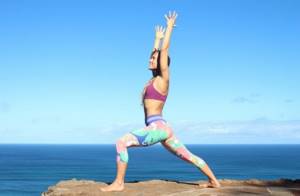
Warrior Pose I is a simple but very useful asana.
Virabhadrasana I strengthens the muscles and joints of the lower extremities, trains the abdominal muscles, strengthens the mental connection with the body, develops coordination, develops confidence and courage.
Video: Nuances of performing Warrior I pose
What are the benefits of morning yoga practice?
Almost all experts consider the morning the best time to practice. No wonder: at the beginning of the day it is easier for us to concentrate on classes. “Besides, the body is rested after sleep, we won’t have to stimulate or nourish ourselves in any way, and the practice will be intense and deep,” says Vladimir Karpov, teacher of universal yoga at the Taste & Color studio .
You will feel the effect of this practice all day. “Morning classes awaken the mind and body,” explains Yulia Gurova, instructor of Hatha Yoga and Iyengar Yoga Network . “During the performance of asanas, muscles and joints are worked out, and internal organs and glands are also stimulated, which ensures the harmonious functioning of the body as a whole.”
In order for the practice to bring maximum benefit, teachers recommend following a few simple rules. First, exercise on an empty stomach. “It is best to perform asanas on an empty stomach, and half an hour after practice you can eat,” says Yulia Gurova.
Secondly, it is worth practicing regularly. It is advisable to do this daily, but 4-5 sessions per week is also a good result.
Twisted Side Angle Pose (Parivritta Parsvakonasana)
This twist may seem difficult at first, the main thing is to act carefully and stop at a point that is comfortable for you.
- We stand in Tadasana (straighten our back, lower our arms to our sides, bring our legs together).
- We take a deep breath, spread the lower limbs to a width of 100–120 centimeters.
- The placement of the feet is the same as in the previous asana: we turn the right foot 90 degrees, and turn the left foot diagonally inward. Bend the right knee at a right angle.
- As you inhale, stretch your arms up, and as you exhale, join your palms and curl toward your right thigh. We cling to the right thigh with our left elbow.
- If you have good flexibility, try to twist so that your palms are at the center of your chest. But do not use excessive force, otherwise you risk damaging the vertebrae. There shouldn't be any pain.
- After 30 seconds in this pose, carefully straighten up.
- Return to the starting position and repeat the movements on the other side.
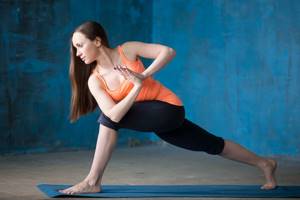
Simplified version of the asana
The asana allows you to lose weight and pump up your thighs and abs; it also helps improve digestion.
Video: How to do Twisted Side Angle pose correctly
Morning hatha yoga
Morning hatha yoga helps invigorate the body, so exercises should be selected so that they fill you with energy and not relax.
In Hatha Yoga there is a morning complex - Surya Namaskar, or “Sun Salutation”. Together, these asanas form a single physical sequence that helps to wake up the body and fill the body with energy for the whole day.
To cheer up, it is enough to perform 3-4 circles of Surya Namaskar. Perform the complex dynamically - fix one pose as you inhale, and as you exhale, take the next asana.
In the classic version, Surya Namaskar consists of 12 asanas replacing each other. This is what the complex looks like:
Downward Facing Dog Pose (Adho Mukha Svanasana)
The famous Downward Facing Dog pose, also known as Adho Mukha Svanasana, is perfect for those who want to perk up in the morning. It activates many muscles, strengthens the legs, promotes digestion, and ensures blood flow to the head.
- We get on all fours, the bases of our palms should be under our shoulders, and our knees should be under our pelvic bones.
- Exhale and lift your pelvis up, straightening your legs.
- We try to fully straighten our knees, pulling our heels towards the floor.
- We evenly distribute the body weight on the upper and lower limbs, do not raise the head, and the neck is relaxed.
- We try to keep our back straight, we expand the area of the shoulder blades, directing the shoulder blades towards the front of the body, and not moving them.
- We are in the pose for about 30–60 seconds.
- As we inhale, we return to all fours.
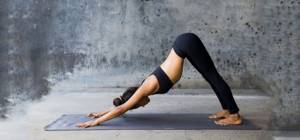
Arms and legs must be straight
This asana will greatly improve the flexibility of your body. The pose also relieves headaches, insomnia and bad mood.
Video: Downward Facing Dog for Beginners
Upward Facing Dog Pose (Urdhva Mukha Svanasana)
This pose can be considered a more powerful version of another well-known yoga backbend - Cobra pose. Urdhva Mukha Svanasana is performed as follows:
- We lie down on a hard surface face down, place our palms under our shoulders, spread our fingers to the sides and tense.
- Resting your palms on the floor and inhaling, we evenly raise your head and body, lower your shoulders a little and move them back.
- We direct our chest forward, bend our back in the lumbar region.
- The hips and pelvis are torn off the floor, the support is only on the palms and the soles of the feet.
- You can keep your head straight or tilt it back slightly, but without bending your neck.
- We do 5-6 breathing cycles, remaining in the asana for 30 to 60 seconds.
- As you exhale, smoothly return to the original position.
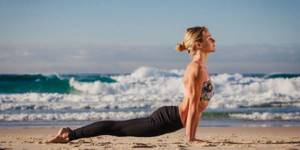
It is important to keep your hips above the surface without straining your buttocks.
Upward Facing Dog Pose is an effective way to combat discomfort in the back area. It trains the muscles of the upper body, stimulates the performance of the lungs and heart, and normalizes the functioning of blood vessels and organs of the abdominal cavity and pelvis. The asana also pumps up the buttocks and abs and gives a boost of energy.
Video: Making Upward Facing Dog correctly
Breathing hatha yoga
Pranayama is a set of breathing practices.
3 Hatha Yoga Breathing Practices
Kapalbhati
Exhale actively through your nose and engage your diaphragm as much as possible. As you exhale, pull in your stomach, and inhale through your nose will happen on its own.
Kalaphati will help:
- Clear the bronchi;
- Fill your body with energy.
Contraindications : menstruation and high blood pressure.
Ujjay Breath
To do the breathing practice, sit comfortably and straighten your back. Inhale slowly through your nose until you hear a “rustle in the throat,” similar to a hissing “O” sound. Then exhale slowly through your nose to hear the hissing sound “A”. While doing the practice, mentally repeat the mantra So Ham, which means “I am God.” Once you master Ujjayi breathing, you can repeat the practice in everyday life and in any position.
Ujjay breathing will help:
- Calm the mind;
- Relieve stress;
- Reduce blood pressure;
- Gently stimulate the thyroid gland.
Contraindications : low blood pressure and neurological disorders, sinusitis, sinusitis, nasal congestion.
Diaphragmatic breathing
Lie on your stomach, take 5-6 breaths. Engage your lower abdomen: lift it as you inhale and lower it as you exhale. Then begin to breathe through your chest, tensing the muscles of your lower abdomen so that it does not bulge forward as you inhale. Now lift your chest and expand it.
Diaphragmatic breathing in Shavasana pose will help:
- Fill your mind and body with energy;
- Calm the mind;
- Relieve muscle tension in the chest, abdomen and pelvis.
Contraindications : high blood pressure and operations on internal organs undergone in the last year.
To make hatha yoga classes effective, sign up for courses. There they will teach you how to breathe correctly, show you how to do hatha yoga asanas and create a set of exercises for each workout.
The cost of one hatha yoga class is from 300 to 3,000 rubles. The price depends on the status of the school, the duration of the training and the course program.
3 tips on how to choose hatha yoga courses
- Read reviews about different teachers and consult with friends who are already attending hatha yoga classes;
- Go to trial training with different teachers;
- Choose a teacher with whom you feel comfortable studying.
If you regularly practice hatha yoga, your body will thank you, and your internal changes will pleasantly surprise you. Don't be afraid to start - you will definitely succeed!
This training may be right for you:
- 10 Best Yoga Courses in St. Petersburg
- Best Yoga Training Courses from 1,200 Rubles
- 10 Best Stretching, Pilates and Yoga Courses
- 10 Best Yoga Studios in St. Petersburg
Did you like the article? Then like or repost so as not to lose it! Tell us in the comments which direction of yoga is closest to you?
Hare Pose (Shashankasana)
Shashankasana is perfect for those who have just started practicing yoga. The Hare pose does not require special sports training, but, nevertheless, it perfectly relaxes the body, acting as an energy boost.
- We sit down with our legs bent under us, our back straight. Big toes together, knees slightly to the sides.
- As we inhale, we point our arms up, leaving our shoulders down.
- As you exhale, lower your body and arms, maintaining extension. We place our palms on the floor, stretch our stomach and lower ribs towards the floor, trying to place them between our thighs. The buttocks do not come off the heels.
- Relax and stretch for one or several minutes.
- As you inhale, gently bring your palms to your hips and take your original position.
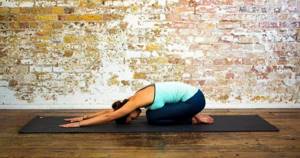
Asana relieves fatigue and tones muscles
The Hare pose calms the nervous system, stimulates emotional uplift and mental activity, relieves irritability and headaches. Regular practice of Shashankasana improves posture and mobility of the spine.
Preparation for yoga
It is important to evaluate your preparation for performing complex asanas; if they are not observed, then you are a beginner.
For beginners, there is a special simplified set of tasks to give flexibility and strength to the body. Many people are unaware that an unprepared body can suffer from complex techniques. Read here - Yoga for legs and buttocks - the best poses and exercises for losing weight and tightening muscles (110 photos and videos)
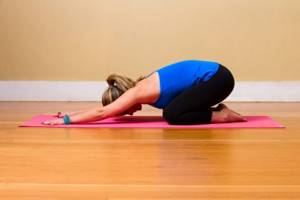
First of all, it is important to always warm up all muscle groups before training. Yes, yoga is a sport, which means, like any sport, it requires special heat and preparation. Before charging, it is better to drink a glass of water and wait a little.
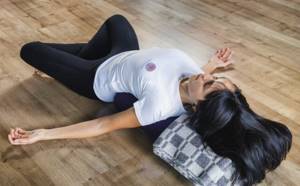
We sit on the floor and fold our legs into a butterfly pose, and keep our back as straight as possible. You should always start warming up with this technique.
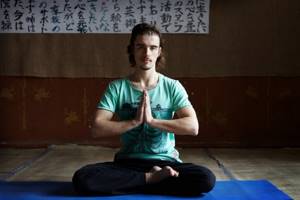
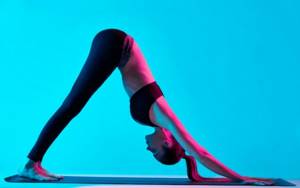
Sun salutation yoga - a set of warm-up exercises and tips for beginners on how to do the exercise correctly (115 photos)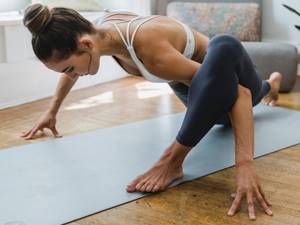
Yoga for beginners at home - an overview of basic workouts and basic exercises. Basic concepts of modern practices (135 photos and videos)
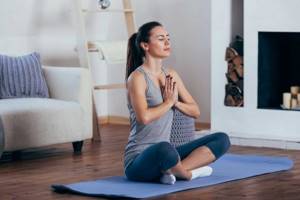
Yoga for women - training programs, basic asanas and exercises. 115 photo and video lessons for beginners
We breathe evenly, leave our eyes slightly open, and don’t forget to watch your back.
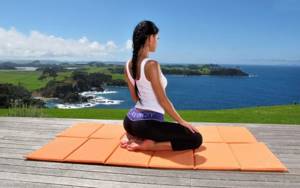
In this position, we make rotating movements with our eyes under closed eyelids, so the head and body will be maximally prepared for the upcoming loads.
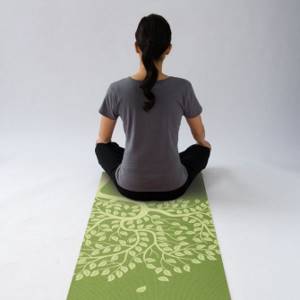
After 5 minutes, we stretch our arms up and complete the workout.
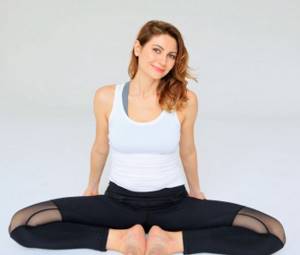
It may seem that this is not a warm-up at all, but by following these steps for 15 minutes with a completely straight back, you can warm up thoroughly.
Dead Body Pose (Savasana)
This is an asana that completes any yogic practice, including morning ones. Corpse pose will allow you to relax physically and mentally as much as possible.
- Turn off electronic devices and make sure that people in your household will not disturb you.
- The room should be warm. You can cover yourself with a blanket or a blanket in advance, even if you are now very warmed up by exercise, since the metabolism in a relaxed body slows down and it begins to freeze faster.
- We lie with our backs on the floor, stretch our upper limbs in different directions with our palms up, and place our legs hip-width apart or slightly wider.
- We close our eyes; you can additionally use a blindfold.
- We focus on breathing, which should remain smooth and calm.
- Mentally we begin to relax all parts of our body.
- We direct attention to the feet, legs, knees, hips, buttocks, stomach, arms, ribs, chest, back, neck, facial muscles, and the entire surface of the head.
- We relax mentally, try not to fixate on any thoughts that arise, just let them go.
- Having finished relaxing, we gradually return to the real world, slowly emerging from Shavasana. To do this, you can gently move your feet and hands, turn on a comfortable side and sit down smoothly.
It is advisable to remain in the Dead Body Pose for at least 5–10 minutes.
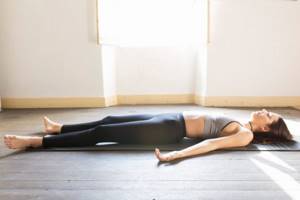
At the same time the most relaxing and invigorating asana
While performing the asana, try to relax as much as possible, but not fall asleep.
Set your alarm clock
“We can afford another five or ten minutes,” we think, setting the alarm clock for a later time, instead of getting out of bed and going to wash. But it turns out that even such a habit can help you wake up. But only if you spend these minutes not on sleep, but on meditation in the morning.
“If you find the strength to do a short meditation instead of these extra 10 minutes of sleep, this will not only “wake up” your brain and allow you to finally wake up, but will also set you up for a relaxing day,” says yoga teacher, yoga therapist and AnySports expert Anastasia Leonova . “By the way, meditation can be done while sitting on the bed.”
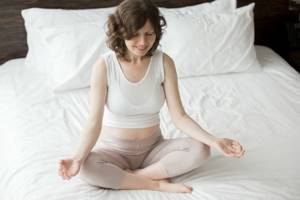
Meditation should be regular: five-minute daily sessions will be much more effective than a two-hour session once a week. As you do this, try to relax and calm down by focusing on your breathing. At first, a short meditation is recommended - energy will fill you even after 5-10 minutes of practice. Gradually you can increase the time.
